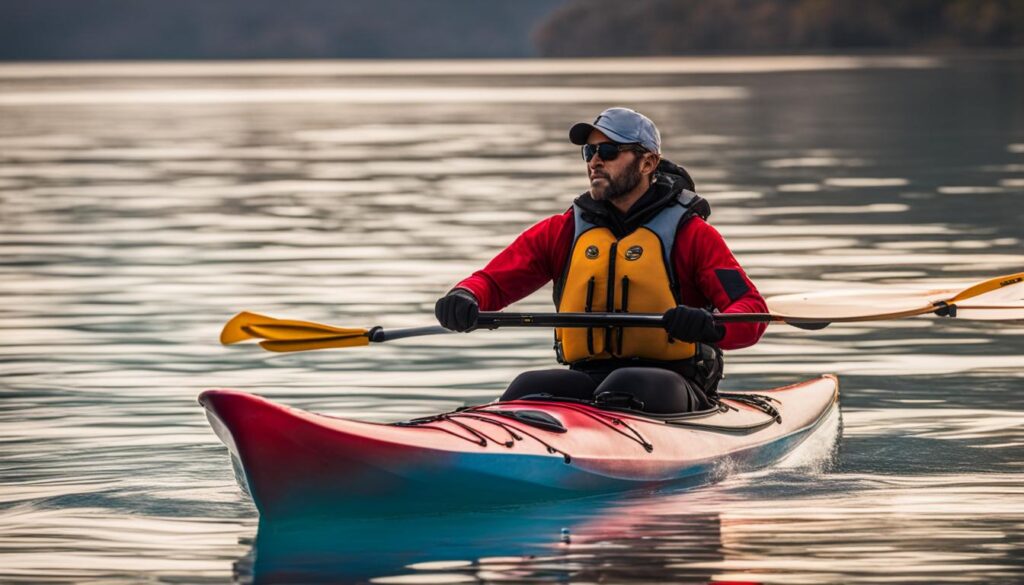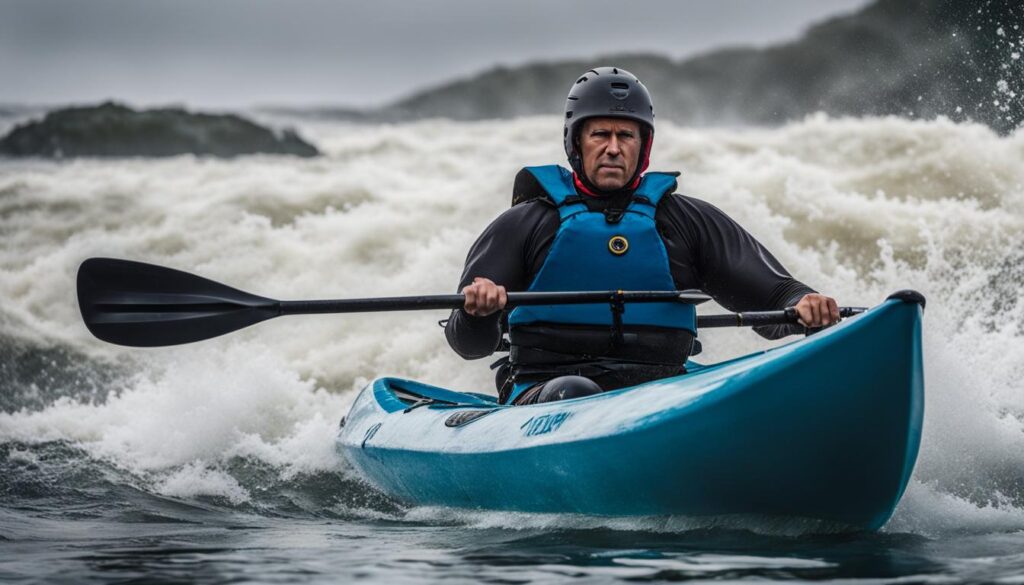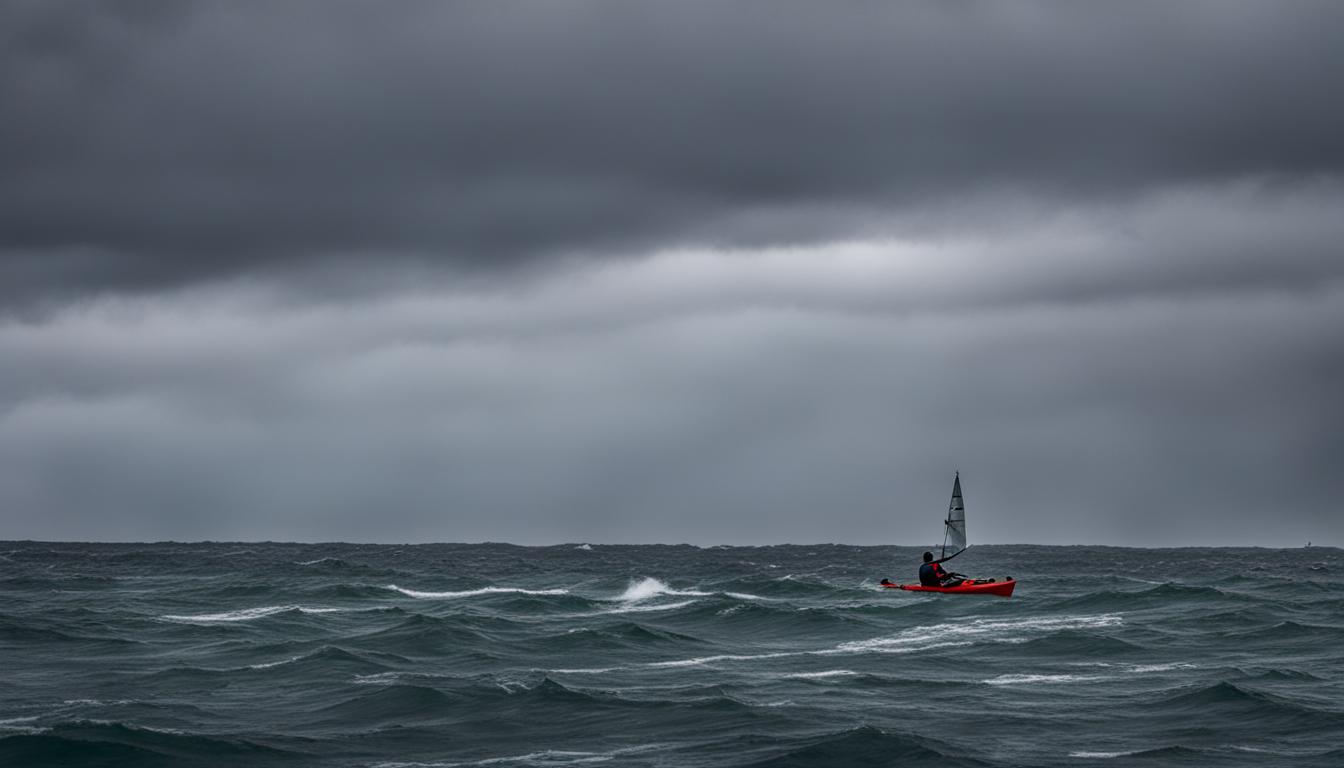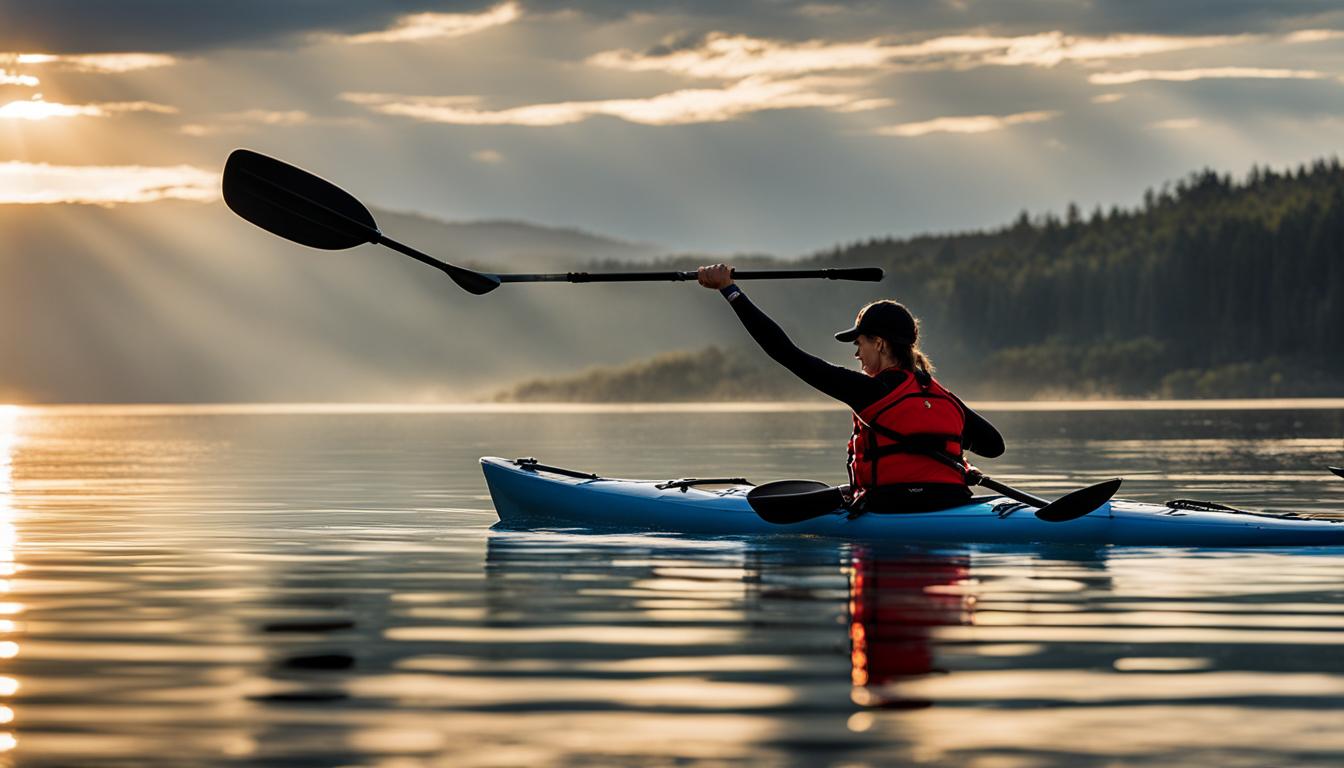When it comes to kayaking in windy conditions, maintaining proper balance and stability is essential. Improper weight distribution can cause your kayak to tilt or tip, making it difficult to control. To ensure a smooth ride, it’s important to adjust your kayak’s weight and balance. Here are some tips and tricks to help you achieve stability even on the windiest of days.
Key Takeaways:
- Proper weight distribution is crucial for kayak stability in windy conditions.
- Spread out your gear evenly and keep the weight centered to maintain balance.
- Face the wind and ride the waves to improve kayak stability.
- Ensure your kayak is properly inflated to maintain stability.
- Consider adding stability aids such as stabilizer bars or ballast bags.
Proper Weight Distribution for Kayak Stability
Proper weight distribution is crucial for ensuring stability and balance in your kayak. Incorrect weight distribution can lead to a tilted or unstable kayak, making it difficult to maneuver in windy conditions. To achieve optimal stability, it is essential to keep the weight centered and evenly spread throughout the kayak.
When loading your gear, make sure to distribute the weight evenly to avoid creating an imbalance. Heavier items should be placed on the floor of the kayak, while lighter gear can be placed on top. This helps maintain a lower center of gravity, which enhances stability. Additionally, when kayaking with others, ensure that everyone is seated in the correct spot to achieve proper weight distribution.
By following these weight distribution techniques, you can improve the stability of your kayak and enjoy a safer and more comfortable paddling experience.
Table: Proper Weight Distribution Tips
| Tip | Description |
|---|---|
| Center the Weight | Keep the weight centered in the kayak to maintain balance. |
| Spread Out Gear | Distribute gear evenly throughout the kayak to prevent imbalance. |
| Sit in the Right Spot | Ensure everyone is sitting in the correct position to achieve proper weight distribution. |
Proper weight distribution is key to maintaining stability in your kayak. By keeping the weight centered and spreading out gear evenly, you can paddle with confidence, even in windy conditions.
Managing Wind and Waves for Kayak Stability
When kayaking in windy conditions, it’s essential to understand how wind and waves can affect the stability of your kayak. By adjusting your technique and being mindful of the elements, you can maintain better balance and control on the water.
Facing the Wind
One of the key strategies for managing wind in a kayak is to face into it. By paddling into the wind, you reduce the impact and prevent your kayak from being pushed off course. This also helps to maintain better stability, as the wind can create uneven forces on the kayak if it hits it from the side. Steer your kayak directly into the wind, keeping your body aligned with the direction you want to go.
Riding the Waves
In wavy conditions, it’s important to ride the waves to maintain balance and stability. Try to keep your kayak perpendicular to the waves, rather than parallel. This allows the kayak to ride over the waves rather than being rocked or tilted by them. Keep your body loose and relaxed, using your core muscles to absorb the movements of the water. By riding the waves in this way, you’ll have better control and stability in challenging conditions.
Lowering the Center of Gravity
Another technique to improve stability in windy and wavy conditions is to lower your center of gravity. This can be achieved by sitting lower in the kayak or using a ballast to weigh down the kayak. By lowering your center of gravity, you create a more stable base and make it easier to balance. Experiment with different seating positions and equipment adjustments to find what works best for you.
| Facing the Wind | Riding the Waves | Lowering the Center of Gravity | |
|---|---|---|---|
| Advantages | Reduces the impact of the wind | Allows the kayak to ride over waves | Creates a more stable base |
| Techniques | Paddle into the wind | Keep kayak perpendicular to waves | Sit lower in the kayak or use a ballast |
| Tips | Face your body in the desired direction | Stay loose and use core muscles | Experiment with seating and equipment adjustments |
Importance of Proper Inflation for Kayak Stability
Proper inflation is critical for maintaining stability and balance in your kayak. Achieving the right air pressure in your kayak ensures optimal performance and control on the water. When it comes to proper inflation, there are a few key factors to consider:
- Manufacturer’s Recommendations: Always refer to the manufacturer’s guidelines for the recommended inflation pressure for your kayak. This information can usually be found in the owner’s manual or on the kayak itself.
- Pressure Gauge: Use a pressure gauge to accurately measure the air pressure in your kayak. This allows you to ensure that you are inflating it to the correct level and make adjustments as needed.
- Monitor Air Pressure: It’s important to regularly monitor the air pressure in your kayak throughout your trip. Changes in temperature can cause the air pressure to fluctuate, so it’s a good practice to check the pressure periodically and make adjustments as necessary.
Proper inflation not only enhances stability but also increases buoyancy, making it easier to navigate through various water conditions. By following these guidelines, you can ensure that your kayak is properly inflated for a safe and stable paddling experience.
Proper inflation is crucial for maintaining stability and balance in a kayak.

Table: Kayak Inflation Guidelines
| Kayak Model | Inflation Pressure |
|---|---|
| Sit-on-Top Kayak | 12-15 PSI |
| Recreational Kayak | 8-12 PSI |
| Sea Kayak | 10-14 PSI |
| Inflatable Kayak | 3-6 PSI |
In the table above, you can find general guidelines for kayak inflation pressure based on different kayak models. However, always refer to your specific kayak’s manufacturer recommendations for the most accurate inflation pressure.
Adding Stability Aids for Improved Kayak Balance
If you’re still experiencing issues with stability and balance in your kayak, don’t worry, there are several stability aids you can add to enhance your kayaking experience. These stability aids can provide extra support, improve maneuverability, and increase your confidence on the water.
Stabilizer Bar
One popular stability aid for kayaks is a stabilizer bar. This attachment can be easily installed on the sides of your kayak and helps improve stability by widening the kayak’s base. The stabilizer bar provides additional support and prevents the kayak from tipping over, especially in rough waters or when carrying heavier loads. It’s a great option for those seeking extra balance and stability.
Ballast Bags
Ballast bags are another effective stability aid. These bags are designed to be filled with water and strategically placed in the kayak to add weight and lower the center of gravity. By adjusting the placement and amount of water in the ballast bags, you can fine-tune the stability of your kayak and ensure optimal balance. Ballast bags are particularly helpful for kayakers who frequently encounter challenging conditions or carry heavy gear.
Outriggers
Outriggers are commonly used on kayaks and canoes to enhance stability. These side-mounted floats create a wider base, making the kayak more stable and resistant to tipping. Outriggers are especially beneficial for beginners or kayakers who want maximum stability while fishing, taking photographs, or engaging in other stationary activities. They provide an added sense of security and confidence on the water.
| Stability Aid | Features | Benefits |
|---|---|---|
| Stabilizer Bar | Side-mounted attachment | Improves stability in rough waters Widens the kayak’s base Prevents tipping |
| Ballast Bags | Water-filled bags | Adds weight and lowers center of gravity Customizable for optimal balance Enhances stability in challenging conditions |
| Outriggers | Side-mounted floats | Creates a wider base for maximum stability Useful for fishing and stationary activities Increases confidence on the water |
By incorporating these stability aids into your kayaking adventures, you can greatly improve your balance, stability, and overall enjoyment on the water. Remember to choose the stability aids that best suit your needs and preferences. Experiment with different combinations to find the perfect setup that gives you the confidence to explore the world of kayaking with ease.
Practicing Proper Boating Techniques for Kayak Stability
When it comes to maintaining stability and balance in your kayak, practicing proper boating techniques is paramount. By following these techniques, you can enhance your paddling experience and ensure a safe and enjoyable time on the water.
Mindful of Movement in Your Kayak
One key aspect of maintaining stability is being mindful of your movement in the kayak. Avoid sudden movements or shifting your weight too quickly, as this can cause the kayak to become unstable. Instead, focus on smooth and controlled motions, keeping your body centered and stable.
Additionally, it’s important to distribute your weight evenly throughout the kayak. Pay attention to how your body weight is distributed and make adjustments as necessary to maintain balance. By keeping your center of gravity low and centered, you’ll have better control over your kayak in various conditions.
Awareness of Your Surroundings
Another crucial aspect of practicing proper boating techniques is maintaining awareness of your surroundings. Always be mindful of potential hazards such as rocks, shallow areas, or other boats. By staying alert and proactively avoiding obstacles, you can prevent accidents and ensure a more stable kayaking experience.
It’s also important to consider the impact of external factors such as wind and waves. Adjust your paddling technique and positioning to face the wind, which will help you maintain stability and stay on course. Similarly, when navigating waves, try to keep your kayak perpendicular to them to minimize rocking and tilting.
By practicing these proper boating techniques, including being mindful of your movement in the kayak and maintaining awareness of your surroundings, you can greatly improve your kayak stability. Remember to always prioritize safety and enjoy the serenity of paddling in balance with nature.

Mastering the Kayak Balance Brace for Added Stability
The Technique for Kayak Balance
When it comes to maintaining stability and control in challenging conditions such as choppy water or rapids, mastering the kayak balance brace can be a game-changer. The kayak balance brace is a technique used by experienced kayakers to navigate these turbulent waters while keeping their balance and control.
The kayak balance brace involves placing the kayak at its capsize point, where it is on the edge of tipping over. The paddler then uses upper body flotation and a Greenland-style paddle, known for its versatility, to maintain stability and control. By utilizing these tools, kayakers can stay in place and navigate their way through challenging conditions without leaving the boat.
This technique is especially useful in rapids or choppy waters where maintaining stability is crucial. The kayak balance brace allows the paddler to steady the kayak while stretching out their lower body, providing relief and preventing fatigue. It requires practice and experience to perfect, but it can greatly enhance a kayaker’s ability to maintain stability and balance in challenging environments.
Mastering the kayak balance brace can be an invaluable skill for kayakers who love to venture into rough waters. By utilizing this technique, paddlers can maintain their balance and control, even in choppy conditions. Practice this technique in a safe and controlled environment, gradually building up your skills and confidence. Remember to always prioritize safety and wear the appropriate safety gear when kayaking in challenging conditions.
Table: Comparing Kayak Stability Techniques
| Technique | Advantages | Disadvantages |
|---|---|---|
| Kayak Balance Brace | – Provides stability in choppy water or rapids – Allows for stretching out the lower body – Enhances control and maneuverability |
– Requires practice and experience – Not suitable for beginners – Paddler must have strong upper body strength |
| Stabilizer Bars | – Increases overall stability of the kayak – Reduces the risk of tipping over – Suitable for beginners or those who struggle with balance |
– Additional weight and bulkiness – Can impact maneuverability – Limited compatibility with certain kayak models |
| Ballast Bags | – Lowers the center of gravity, increasing stability – Can be easily adjusted for optimal balance – Provides additional weight without compromising maneuverability |
– Requires careful placement to avoid interfering with paddling – Can take up valuable space in the kayak – Need to monitor and adjust weight distribution |
| Outriggers | – Creates a wider base for increased stability – Provides additional buoyancy – Suitable for fishing or other activities that require stability |
– Adds extra weight and bulkiness – Can impact maneuverability – Installation and removal can be time-consuming |
Table: Comparing Kayak Stability Techniques
Conclusion
As you wrap up your kayaking adventure, it’s important to remember the key tips and tricks for maintaining a safe and stable experience on the water. By following these guidelines, you can ensure a smooth and enjoyable journey:
First, focus on proper weight distribution. Keep the weight centered and spread out gear evenly to maintain balance. This will prevent your kayak from tilting or tipping.
Next, be mindful of wind and waves. Face the wind while boating to minimize its impact and ride the waves by keeping your kayak perpendicular to them. This will help you maintain stability and avoid unnecessary rocking or tilting.
Additionally, pay attention to inflation. Ensure your kayak is properly inflated according to the manufacturer’s recommendations. Use a pressure gauge to monitor the air pressure, and make adjustments as needed to maintain stability and balance.
Lastly, consider adding stability aids such as stabilizer bars, ballast bags, or outriggers if you still encounter stability issues. These tools can provide an extra layer of stability and help lower the kayak’s center of gravity.
By incorporating these tips and tricks into your kayaking routine, you’ll be well-equipped to enjoy a safe and stable experience on the water. So grab your paddle, embrace the adventure, and have a fantastic time exploring the world of kayaking!
FAQ
What is the importance of proper weight distribution for kayak stability?
Proper weight distribution is crucial for maintaining kayak stability. It involves keeping the weight centered and balanced in the kayak to prevent tilting or tipping.
How do I achieve proper weight distribution in my kayak?
To achieve proper weight distribution, spread out your gear evenly and avoid placing all the weight at one end of the kayak. Heavier gear should be placed on the floor of the kayak, while lighter gear can be placed on top.
How can I manage wind and waves to maintain kayak stability?
To maintain stability in windy conditions, face the wind while boating to minimize its impact. When encountering waves, ride over them by keeping the kayak perpendicular to the waves. Lowering the center of gravity can also help improve stability.
Why is proper inflation important for kayak stability?
Proper inflation is essential for maintaining kayak stability. Overinflating or underinflating can affect the kayak’s performance and make it difficult to control. Check the manufacturer’s recommendations for the proper inflation pressure and regularly monitor the air pressure throughout the day.
Are there any stability aids I can add to my kayak?
Yes, you can add stability aids such as stabilizer bars, ballast bags, and outriggers to improve kayak stability. Stabilizer bars can be attached to the sides of the kayak, ballast bags add weight and lower the center of gravity, and outriggers create a wider base for increased stability.
What are some techniques for practicing proper boating for kayak stability?
Practicing proper paddling techniques, such as keeping the paddle low to the water and using smooth, even strokes, can help maintain balance and stability. Avoid sudden movements or shifting weight too quickly, and be mindful of your surroundings to avoid potential hazards.
How can the kayak balance brace technique improve stability?
The kayak balance brace technique is a valuable tool for maintaining stability in challenging conditions. It involves using upper body flotation and a Greenland-style paddle to stay in place while placing the kayak at its capsize point. This technique can help steady the kayak and allow for stretching out the lower body without leaving the boat.
What are some overall tips for achieving a safe and stable kayaking experience?
Follow these tips and tricks to achieve a safe and stable kayaking experience: maintain proper weight distribution, manage wind and waves, ensure proper inflation, consider adding stability aids, practice proper boating techniques, and master the kayak balance brace technique.
Source Links
- http://www.kayakforum.com/cgi-bin/Building/archive.pl/bid/12/md/read/id/65925/sbj/kayak-weight-balance/
- https://kayakish.com/blogs/news/solving-issues-with-stability-or-balance-on-an-inflatable-boat
- https://kayakinginfo.com/kayaking-with-the-kayak-balance-brace-tips-and-tricks-for-a-more-enjoyable-experience/





